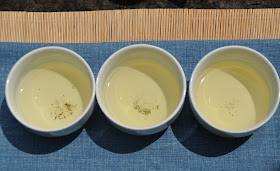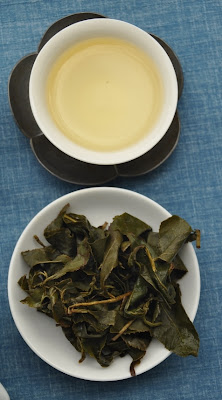 |
| Oolong plantation on Da Yu Ling |
On this familiar rock, I set up my Chaxi with 3 white porcelain competition sets to compare 3 mountains with plantations over 2000 meters high. The blue fabric on the bamboo mat symbolizes the intense and clear blue sky at such elevations.
From left to right, the teas are all luanze Oolong:
Origin: Lishan
Elevation: 2200 meters
Hand harvested on April 17th, 2013.
(Left on the Chaxi)
Origin: Da Yu Ling
Elevation: 2300 meters
Hand harvested on April 20th, 2013.
(In the middle of the Chaxi)
Origin: Qilai Shan
Elevation: 2050 meters
Hand harvested on May 10th, 2013.
(Right on the Chaxi)
There are some obvious visual differences for the dry leaves from these 3 different mountains. The Lishan seem biggest, while the Da Yu Ling leaves look the greenest.
Does this means that there are also big differences in the oxidation level. Let's find out! I'm brewing these leaves for 6 minutes:
 |
| Lishan, Da Yu Ling and Qilai |
 |
| Lishan, Da Yu Ling and Qilai |
In the outdoors, it's more difficult to analyze a tea in great detail. And when you compare 3 at a time, what you remember are the main differences. Let me start with these impressions and then give you my tasting notes from other (indoor) tastings:
(Left) Lishan: Elegance
This tea is very sweet and light. Compared to the 2 others, it feels more 'elegant', very easy to drink. The Chaqi is very subtle and playful. On the first brew, it's almost beating the Da Yu Ling!
The fragrances are also the lightest and most flowery.
It brings a clean, pure mouthfeel with a nice cooling sensation that is common to all these 3 high mountain Oolongs.
It has the finesse of a solo violin playing baroque music.
(Middle) Da Yu Ling: Power
Da Yu Ling has almost the same sweetness, but it packs more power in a still very harmonious way. The tea tastes thick without turning bitter. It's delicious and has the greatest durability/brewability.
This 'thickness' means also that this tea has a lot of complexity and evolves from brew to brew. Amazing!
This Oolong is more like a cello (played by Ma, Yo Yo!)
(Right). Qilai : Fruity
Qilai shan has the properties you'd expect from a top High Mountain Oolong. The sweetness and power are good. It has an added dryness which adds to the aftertaste. The fragrances feel a little more fruity, as the leaves seem slightly more oxidized.
Brewed with a competition set, the taste appears less 'elegant', less smooth than the 2 others. But if you brew it alone with greater care, than I have found that this is hardly noticeable.
Qilai would be closer to an organ instrument.
Tasting 3 top mountain Oolongs from this spring side by side is a chance to enjoy the character of each mountain. Compared with previous years, I have found that this character is something that doesn't change much.
The second brew was even a little bit stronger than the first. These Oolongs have very long leaves and it takes time to release all their fine and powerful flavors!
It's a pleasure to enjoy the clear blue sky and spring mountain air from each of these peaks!














Stephane, great pictures! Is there a "scientific" explanation why liquor clarity is associated with high quality?
ReplyDeleteThanks Hektor,
ReplyDeleteI don't know how to explain it scientifically. Maybe we can point to water (tea is 99% water) and observe that clean water is necessarily transparent and clear.
If a tea is unclear to the eye, then it means that the leaves have released quite big components that are not fully dissolved in water. These components must be heavier than those that dissolve well and therefore they carry a heavier (bitter and/or astringent) taste and overwhelm the light fragrances.
George B. has asked me to post his comment:
ReplyDelete"Greatly enjoyed the Da Yu Ling Oolong tea from Stephane. My wife and guests were really amazed at the flavor. It was even more enjoyable in my Yixing tea pot and a beautiful cup that I bought from Stephane last year!!"